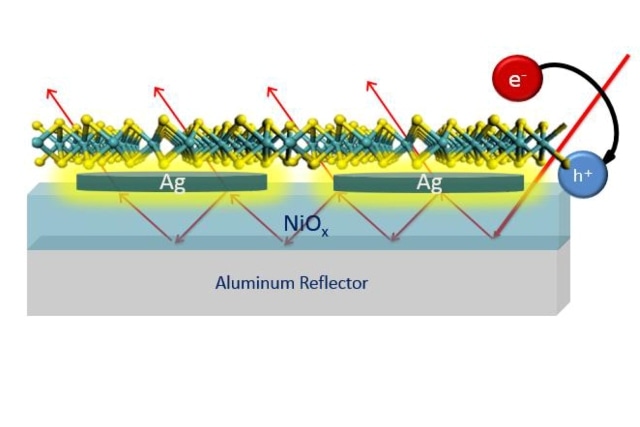May 5 2016
 Using a layer of molybdenum disulfide that was less than one nanometer thick, researchers in Rice University’s Thomann lab were able to design a system that absorbed more than 35 percent of incident light in the 400- to 700-nanometer wavelength range. (Image by Thomann Group/Rice University)
Using a layer of molybdenum disulfide that was less than one nanometer thick, researchers in Rice University’s Thomann lab were able to design a system that absorbed more than 35 percent of incident light in the 400- to 700-nanometer wavelength range. (Image by Thomann Group/Rice University)
Molybdenum disulfide (MoS2) is used as an effective lubricant in motorcycle and aircraft engines, and in the universal and CV joints of automobiles and trucks. The material also exhibits a remarkable light absorption property, according to Isabell Thomann, an engineering researcher at Rice University. This quality makes molybdenum disulfide a potential candidate for the development of photocatalytic and optoelectronic devices.
Basically, we want to understand how much light can be confined in an atomically thin semiconductor monolayer of MoS2. By using simple strategies, we were able to absorb 35 to 37 percent of the incident light in the 400- to 700-nanometer wavelength range, in a layer that is only 0.7 nanometers thick.
Isabell Thomann, Engineering Researcher, Rice University
The research work carried by Thomann and Rice graduate students Shah Mohammad Bahauddin and Hossein Robatjazi has been described in a paper titled “Broadband Absorption Engineering To Enhance Light Absorption in Monolayer MoS2,” in ACS Photonics, a journal from the American Chemical Society. The study results hold potential for the development of a range of optoelectronic devices, including photovoltaic solar panels.
Squeezing light into these extremely thin layers and extracting the generated charge carriers is an important problem in the field of two-dimensional materials. That’s because monolayers of 2-D materials have different electronic and catalytic properties from their bulk or multilayer counterparts.
Isabell Thomann, Engineering Researcher, Rice University
Thomann and her collaborators have obtained the breakthrough results by employing experimental optical characterizations, numerical simulations, and analytical models. The use of 3D electromagnetic simulations enabled the researchers to determine that the application of molybdenum disulfide on a Molybdenum disulfide improved the light absorption property by 5.9 times.
If light absorption in these materials was perfect, we’d be able to create all sorts of energy-efficient optoelectronic and photocatalytic devices. That’s the problem we’re trying to solve.
Isabell Thomann, Engineering Researcher, Rice University
Although Thomann is happy with her lab’s progress, she admits that more work still needs to be carried out.
The goal, of course, is 100 percent absorption, and we’re not there yet.
Isabell Thomann, Engineering Researcher, Rice University
The National Science Foundation and the Welch Foundation supported the research work.